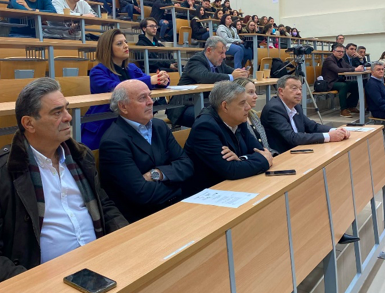In a world facing environmental challenges, upskilling initiatives that empower young individuals to make a positive impact,are more critical than ever. The BLUE-GREENWAY project serves as a shining example of how regional cooperation can not only improve environmental status but also create opportunities for youth to enhance their skills and contribute to sustainable practices. By focusing on water quality monitoring, early warning systems, and e-procurement, BLUE-GREENWAY has fostered mutual knowledge exchange and understanding between beneficiary states, while empowering the youth to become environmental stewards. Let’s explore how the project aligns its outcomes and outputs to create a brighter future for both the environment and young people.
Exchange of Best Practices:
The BLUE-GREENWAY project has achieved remarkable outcomes, notably in enhancing the environmental status of supported ecosystems. Through the implementation of water quality remediation, monitoring and ecological modelling, the project gains valuable insights into environmental challenges, paving the way for the exchange of best practices in environmental restoration and protection. These learnings serve as a valuable resource for young individuals participating in the project, enabling them to effectively address future environmental issues.
Moreover, BLUE-GREENWAY has demonstrated excellence in creating innovative materials for controlling eutrophication, a critical step in ecosystem restoration. The project’s application of these materials through the “teabag” method exemplifies circular practices, emphasizing sustainability and efficient resource utilization.
Furthermore, the integration of circular practices, such as algae ponds in aquaculture, showcases Blue-Greenway’s commitment to environmentally friendly solutions. By employing these ponds, the project not only restores ecosystems but also contributes to the development of sustainable practices in the aquaculture industry.
Through these exemplary efforts, BLUE-GREENWAY continues to empower young individuals with the knowledge and tools needed to champion environmental preservation and make a positive impact on their surroundings.
Leveraging Resources:
As a regional cooperation project, BLUE-GREENWAY effectively leverages resources to achieve its outputs. The development of an early warning system and e-procurement toolkit creates a platform for pooling financial and infrastructural resources. These shared resources ensure that young people have access to cutting-edge technologies and expertise, enabling them to play a vital role in implementing environmental solutions. Additionally, the project’s agricultural drainage water treatment initiatives provide opportunities for youth to engage in green practices while restoring ecosystems.
Policy Alignment, Advocacy, and Collaboration:
BLUE-GREENWAY has successfully aligned policies between donor and beneficiary states, fostering enhanced cooperation and mutual understanding. This alignment ensures that upskilling initiatives are well-integrated into environmental policies, making them more effective and sustainable. Young people, as stakeholders in the project, actively participate in policy discussions, providing them with a unique opportunity to influence and shape the future of environmental stewardship.
The Living Labs in Larissa, Nicosia, and Bucharest have garnered significant interest from local authorities, showcasing the project’s potential for real-world impact.
Furthermore, the project’s participation at the Circle the Med Forum has served as a crucial platform for reaching out to authorities at the national and international levels. This engagement enables BLUE-GREENWAY to advocate for policies that align with its environmental goals, influencing decision-makers and driving positive change.
The upcoming capitalization events are expected to further empower advocacy actions. By bringing together stakeholders, experts, and authorities, these events will foster meaningful discussions and collaborations, reinforcing the importance of sustainable practices and upskilling initiatives in environmental preservation.
Through such collaborative efforts, BLUE-GREENWAY demonstrates its commitment to not only restoring ecosystems but also actively influencing policy and decision-making processes, ensuring a more sustainable and greener future for all.
Strategies Supporting Upskilling Young People:
The project actively incorporates strategies to support the upskilling of young individuals. By providing technical events and capacity-building workshops, BLUE-GREENWAY equips the youth with knowledge and practical skills in environmental management. The establishment of living labs and joint pilot actions further enhances hands-on learning experiences, preparing young individuals to tackle real-world challenges effectively.
Collaboration for Knowledge Exchange:
Through unified platforms on e-procurement and knowledge-sharing seminars, BLUE-GREENWAY facilitates collaboration between beneficiaries and donors. This collaborative approach ensures that best practices, innovative solutions, and research findings are shared across regions. Young people benefit significantly from these exchanges as they gain exposure to diverse perspectives and experiences, broadening their horizons and enhancing their problem-solving abilities.
Impact of Regional Cooperation on Youth Skills and Employment:
The impact of Blue-Greenway’s regional cooperation is evident in the improvement of aquatic ecosystems environmental status, but its influence goes beyond ecological restoration. By fostering upskilling initiatives, the project equips young individuals with valuable skills and expertise. These skills, combined with their commitment to environmental stewardship, make them highly sought-after professionals in the job market, driving the growth of green industries and reducing youth unemployment.
Highlighting Project Activities with Youth:
BLUE-GREENWAY places great emphasis on involving young people in project activities. The joint pilot actions of the e-procurement kit provide hands-on experience in implementing green practices, shaping young individuals into environmental experts. Additionally, the project’s capacity-building workshops and transfer seminars foster a strong sense of ownership among the youth, as they actively engage in environmental conservation efforts.
The BLUE-GREENWAY project exemplifies how regional cooperation can empower young individuals through upskilling initiatives while improving the environmental status of ecosystems. By aligning policies, sharing knowledge, and leveraging resources, the project creates a nurturing environment for youth to become environmental stewards and active contributors to a sustainable future. As the beneficiaries and donors collaborate, the project not only enhances mutual understanding but also paves the way for a brighter and greener tomorrow, led by a skilled and passionate generation of young environmentalists.
Photos from the Living Lab in Larissa


